Employability Skills Report: Assessing Performance and Problem Solving
VerifiedAdded on 2023/01/16
|18
|5802
|28
Report
AI Summary
This report examines employability skills within the context of the National Trust, a heritage and environmental conservation organization. The report begins by outlining personal performance and responsibility objectives, utilizing the SMART framework to define roles and responsibilities for a manager. It assesses individual effectiveness against these objectives, highlighting strengths such as communication and creativity, while identifying weaknesses like team management and problem-solving. Recommendations for improvement are provided, alongside an analysis of motivational techniques, including Maslow's hierarchy of needs and Herzberg's two-factor theory, to enhance employee performance. The report then addresses work-based difficulties, offering solutions through problem analysis and decision-making strategies. It also explores communication methods, time management, and team dynamics, providing advice on achieving common goals and resolving problems. The report concludes with a discussion of tools and methods for problem-solving, including a proposed strategy to address labor turnover, and an assessment of the potential impact of these strategies on the business.
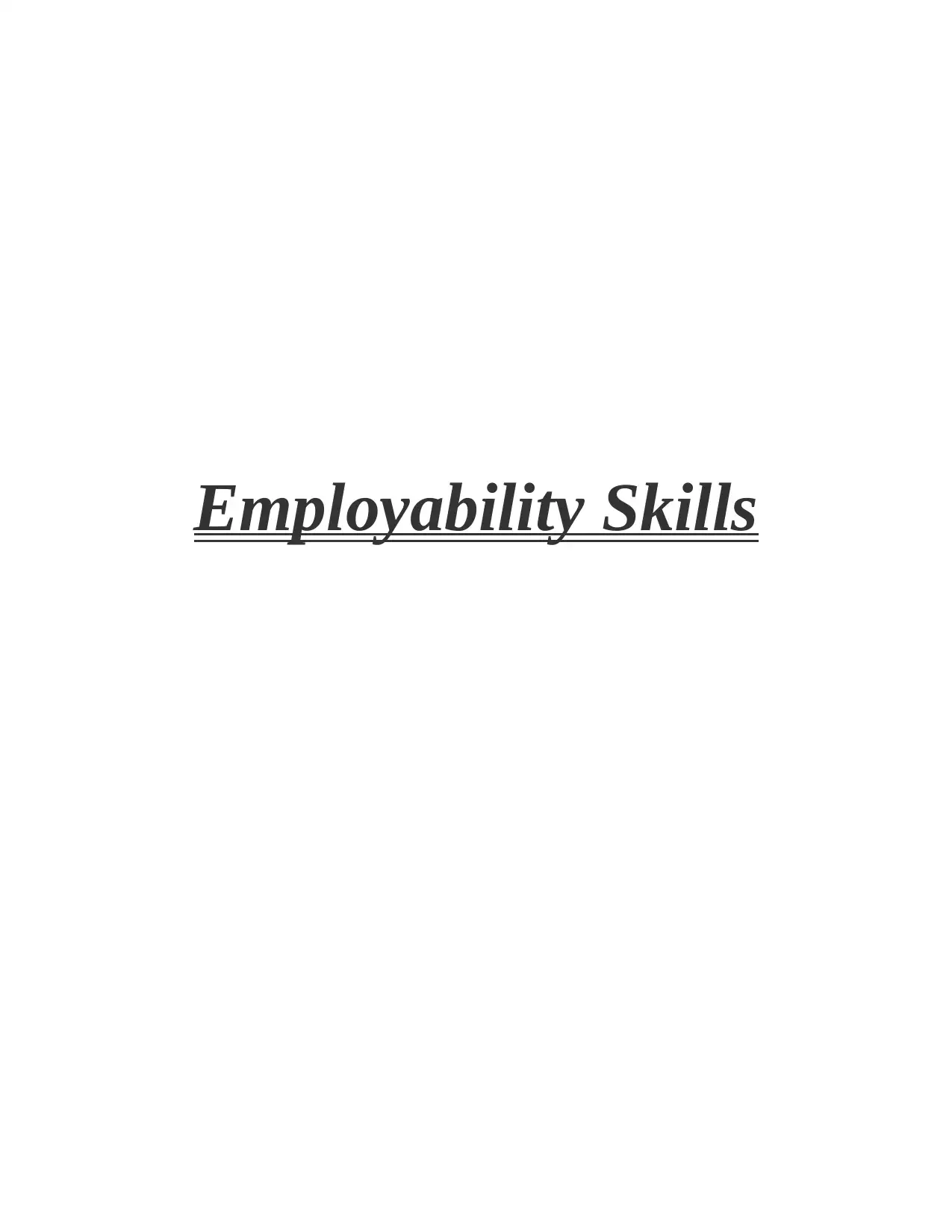
Employability Skills
Paraphrase This Document
Need a fresh take? Get an instant paraphrase of this document with our AI Paraphraser
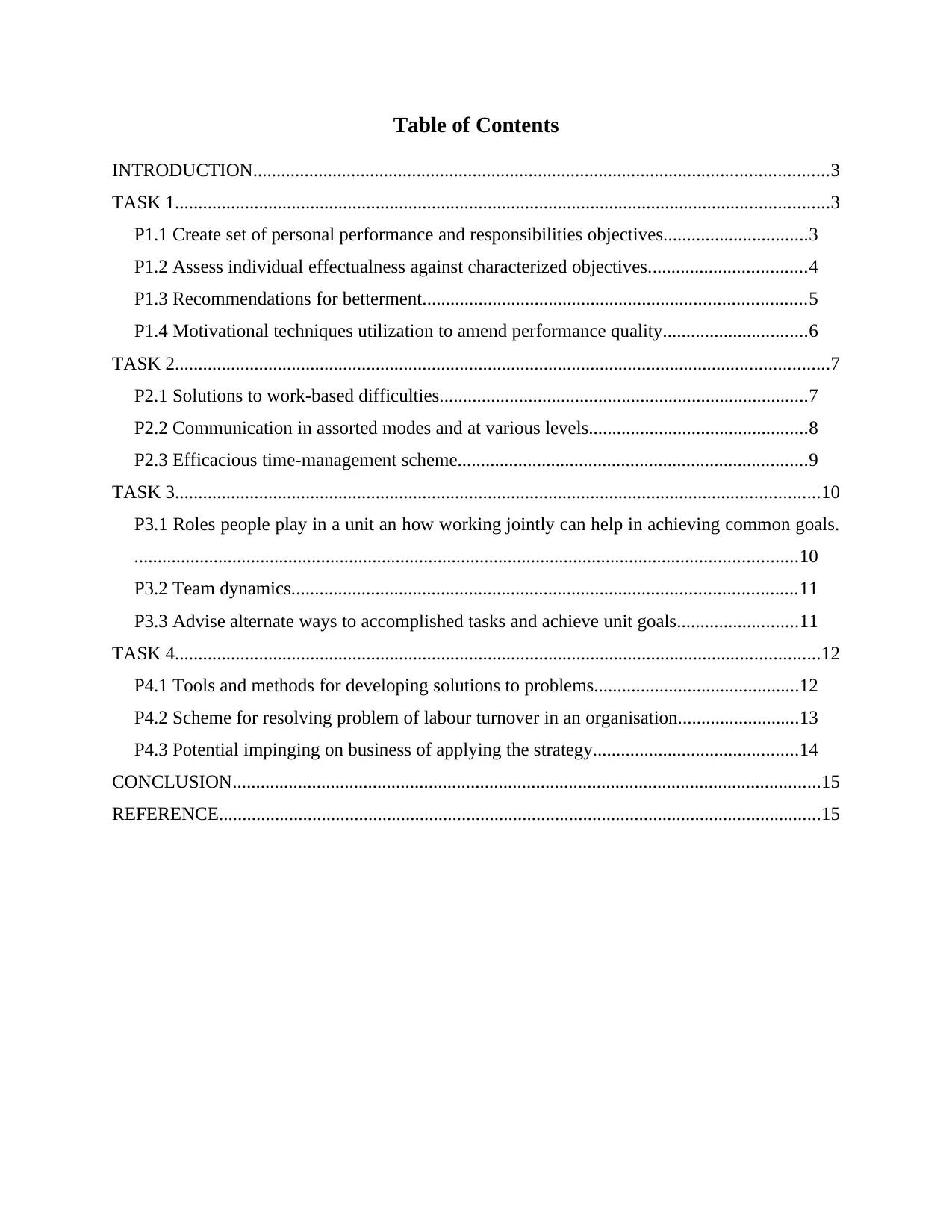
Table of Contents
INTRODUCTION...........................................................................................................................3
TASK 1............................................................................................................................................3
P1.1 Create set of personal performance and responsibilities objectives...............................3
P1.2 Assess individual effectualness against characterized objectives..................................4
P1.3 Recommendations for betterment..................................................................................5
P1.4 Motivational techniques utilization to amend performance quality...............................6
TASK 2............................................................................................................................................7
P2.1 Solutions to work-based difficulties...............................................................................7
P2.2 Communication in assorted modes and at various levels...............................................8
P2.3 Efficacious time-management scheme...........................................................................9
TASK 3..........................................................................................................................................10
P3.1 Roles people play in a unit an how working jointly can help in achieving common goals.
..............................................................................................................................................10
P3.2 Team dynamics............................................................................................................11
P3.3 Advise alternate ways to accomplished tasks and achieve unit goals..........................11
TASK 4..........................................................................................................................................12
P4.1 Tools and methods for developing solutions to problems............................................12
P4.2 Scheme for resolving problem of labour turnover in an organisation..........................13
P4.3 Potential impinging on business of applying the strategy............................................14
CONCLUSION..............................................................................................................................15
REFERENCE.................................................................................................................................15
INTRODUCTION...........................................................................................................................3
TASK 1............................................................................................................................................3
P1.1 Create set of personal performance and responsibilities objectives...............................3
P1.2 Assess individual effectualness against characterized objectives..................................4
P1.3 Recommendations for betterment..................................................................................5
P1.4 Motivational techniques utilization to amend performance quality...............................6
TASK 2............................................................................................................................................7
P2.1 Solutions to work-based difficulties...............................................................................7
P2.2 Communication in assorted modes and at various levels...............................................8
P2.3 Efficacious time-management scheme...........................................................................9
TASK 3..........................................................................................................................................10
P3.1 Roles people play in a unit an how working jointly can help in achieving common goals.
..............................................................................................................................................10
P3.2 Team dynamics............................................................................................................11
P3.3 Advise alternate ways to accomplished tasks and achieve unit goals..........................11
TASK 4..........................................................................................................................................12
P4.1 Tools and methods for developing solutions to problems............................................12
P4.2 Scheme for resolving problem of labour turnover in an organisation..........................13
P4.3 Potential impinging on business of applying the strategy............................................14
CONCLUSION..............................................................................................................................15
REFERENCE.................................................................................................................................15
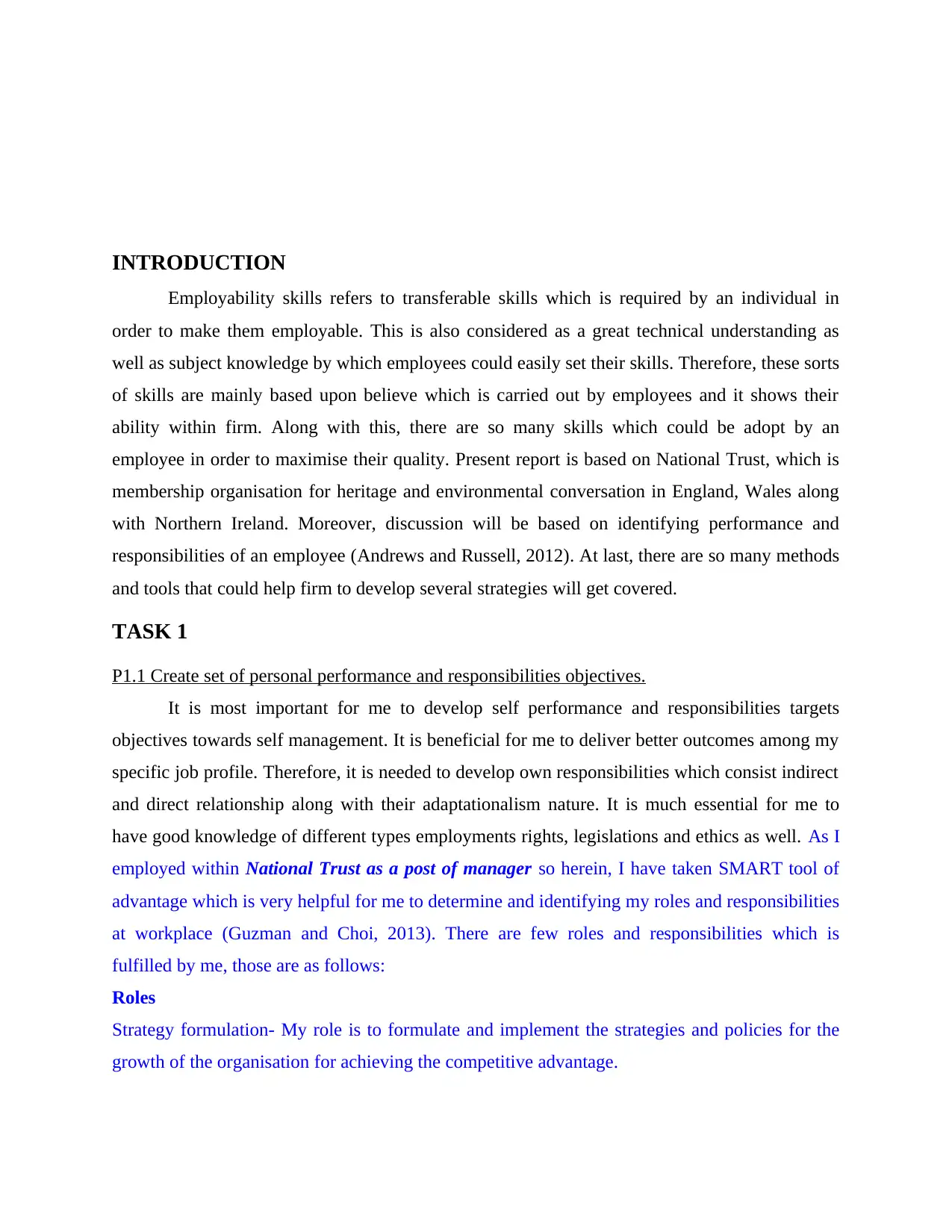
INTRODUCTION
Employability skills refers to transferable skills which is required by an individual in
order to make them employable. This is also considered as a great technical understanding as
well as subject knowledge by which employees could easily set their skills. Therefore, these sorts
of skills are mainly based upon believe which is carried out by employees and it shows their
ability within firm. Along with this, there are so many skills which could be adopt by an
employee in order to maximise their quality. Present report is based on National Trust, which is
membership organisation for heritage and environmental conversation in England, Wales along
with Northern Ireland. Moreover, discussion will be based on identifying performance and
responsibilities of an employee (Andrews and Russell, 2012). At last, there are so many methods
and tools that could help firm to develop several strategies will get covered.
TASK 1
P1.1 Create set of personal performance and responsibilities objectives.
It is most important for me to develop self performance and responsibilities targets
objectives towards self management. It is beneficial for me to deliver better outcomes among my
specific job profile. Therefore, it is needed to develop own responsibilities which consist indirect
and direct relationship along with their adaptationalism nature. It is much essential for me to
have good knowledge of different types employments rights, legislations and ethics as well. As I
employed within National Trust as a post of manager so herein, I have taken SMART tool of
advantage which is very helpful for me to determine and identifying my roles and responsibilities
at workplace (Guzman and Choi, 2013). There are few roles and responsibilities which is
fulfilled by me, those are as follows:
Roles
Strategy formulation- My role is to formulate and implement the strategies and policies for the
growth of the organisation for achieving the competitive advantage.
Employability skills refers to transferable skills which is required by an individual in
order to make them employable. This is also considered as a great technical understanding as
well as subject knowledge by which employees could easily set their skills. Therefore, these sorts
of skills are mainly based upon believe which is carried out by employees and it shows their
ability within firm. Along with this, there are so many skills which could be adopt by an
employee in order to maximise their quality. Present report is based on National Trust, which is
membership organisation for heritage and environmental conversation in England, Wales along
with Northern Ireland. Moreover, discussion will be based on identifying performance and
responsibilities of an employee (Andrews and Russell, 2012). At last, there are so many methods
and tools that could help firm to develop several strategies will get covered.
TASK 1
P1.1 Create set of personal performance and responsibilities objectives.
It is most important for me to develop self performance and responsibilities targets
objectives towards self management. It is beneficial for me to deliver better outcomes among my
specific job profile. Therefore, it is needed to develop own responsibilities which consist indirect
and direct relationship along with their adaptationalism nature. It is much essential for me to
have good knowledge of different types employments rights, legislations and ethics as well. As I
employed within National Trust as a post of manager so herein, I have taken SMART tool of
advantage which is very helpful for me to determine and identifying my roles and responsibilities
at workplace (Guzman and Choi, 2013). There are few roles and responsibilities which is
fulfilled by me, those are as follows:
Roles
Strategy formulation- My role is to formulate and implement the strategies and policies for the
growth of the organisation for achieving the competitive advantage.
⊘ This is a preview!⊘
Do you want full access?
Subscribe today to unlock all pages.

Trusted by 1+ million students worldwide
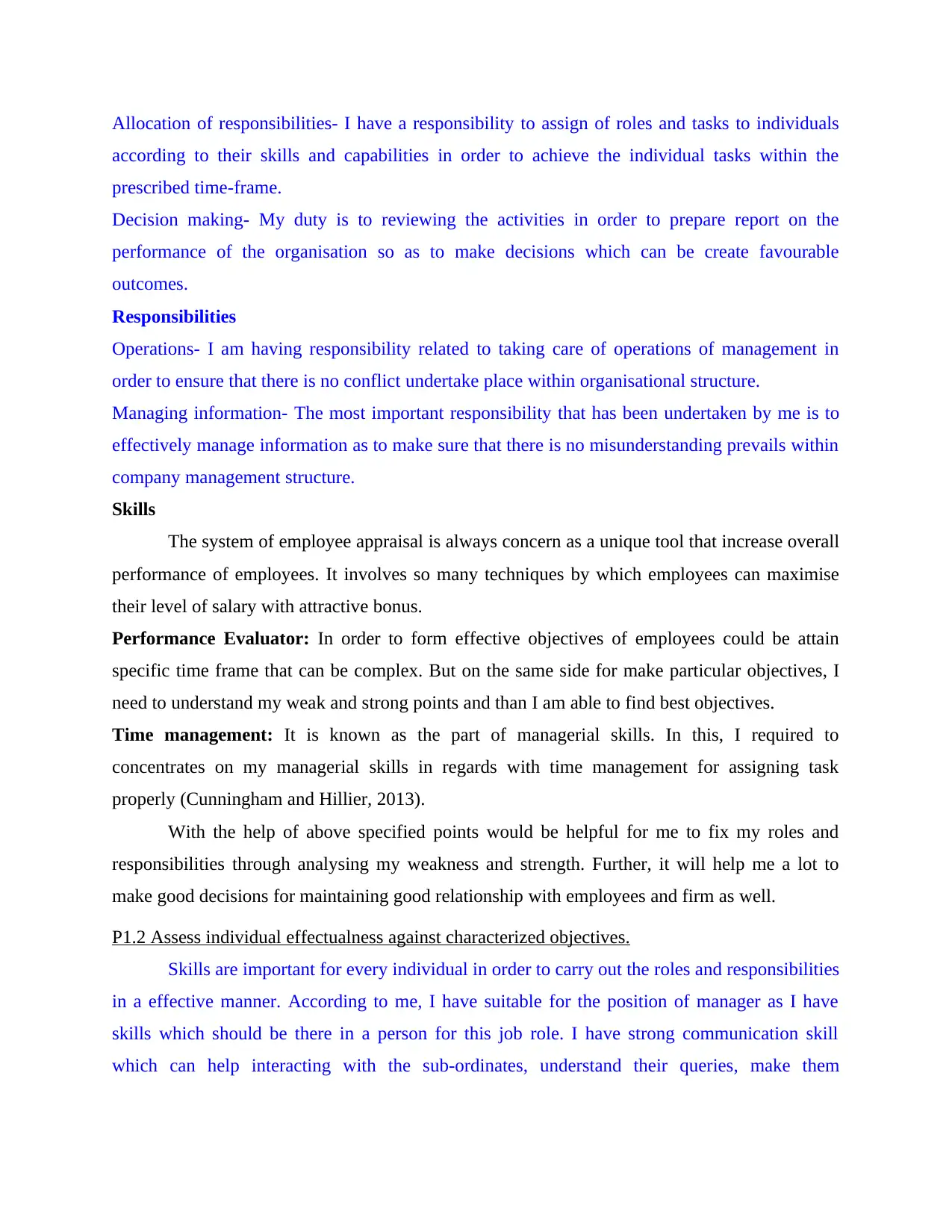
Allocation of responsibilities- I have a responsibility to assign of roles and tasks to individuals
according to their skills and capabilities in order to achieve the individual tasks within the
prescribed time-frame.
Decision making- My duty is to reviewing the activities in order to prepare report on the
performance of the organisation so as to make decisions which can be create favourable
outcomes.
Responsibilities
Operations- I am having responsibility related to taking care of operations of management in
order to ensure that there is no conflict undertake place within organisational structure.
Managing information- The most important responsibility that has been undertaken by me is to
effectively manage information as to make sure that there is no misunderstanding prevails within
company management structure.
Skills
The system of employee appraisal is always concern as a unique tool that increase overall
performance of employees. It involves so many techniques by which employees can maximise
their level of salary with attractive bonus.
Performance Evaluator: In order to form effective objectives of employees could be attain
specific time frame that can be complex. But on the same side for make particular objectives, I
need to understand my weak and strong points and than I am able to find best objectives.
Time management: It is known as the part of managerial skills. In this, I required to
concentrates on my managerial skills in regards with time management for assigning task
properly (Cunningham and Hillier, 2013).
With the help of above specified points would be helpful for me to fix my roles and
responsibilities through analysing my weakness and strength. Further, it will help me a lot to
make good decisions for maintaining good relationship with employees and firm as well.
P1.2 Assess individual effectualness against characterized objectives.
Skills are important for every individual in order to carry out the roles and responsibilities
in a effective manner. According to me, I have suitable for the position of manager as I have
skills which should be there in a person for this job role. I have strong communication skill
which can help interacting with the sub-ordinates, understand their queries, make them
according to their skills and capabilities in order to achieve the individual tasks within the
prescribed time-frame.
Decision making- My duty is to reviewing the activities in order to prepare report on the
performance of the organisation so as to make decisions which can be create favourable
outcomes.
Responsibilities
Operations- I am having responsibility related to taking care of operations of management in
order to ensure that there is no conflict undertake place within organisational structure.
Managing information- The most important responsibility that has been undertaken by me is to
effectively manage information as to make sure that there is no misunderstanding prevails within
company management structure.
Skills
The system of employee appraisal is always concern as a unique tool that increase overall
performance of employees. It involves so many techniques by which employees can maximise
their level of salary with attractive bonus.
Performance Evaluator: In order to form effective objectives of employees could be attain
specific time frame that can be complex. But on the same side for make particular objectives, I
need to understand my weak and strong points and than I am able to find best objectives.
Time management: It is known as the part of managerial skills. In this, I required to
concentrates on my managerial skills in regards with time management for assigning task
properly (Cunningham and Hillier, 2013).
With the help of above specified points would be helpful for me to fix my roles and
responsibilities through analysing my weakness and strength. Further, it will help me a lot to
make good decisions for maintaining good relationship with employees and firm as well.
P1.2 Assess individual effectualness against characterized objectives.
Skills are important for every individual in order to carry out the roles and responsibilities
in a effective manner. According to me, I have suitable for the position of manager as I have
skills which should be there in a person for this job role. I have strong communication skill
which can help interacting with the sub-ordinates, understand their queries, make them
Paraphrase This Document
Need a fresh take? Get an instant paraphrase of this document with our AI Paraphraser
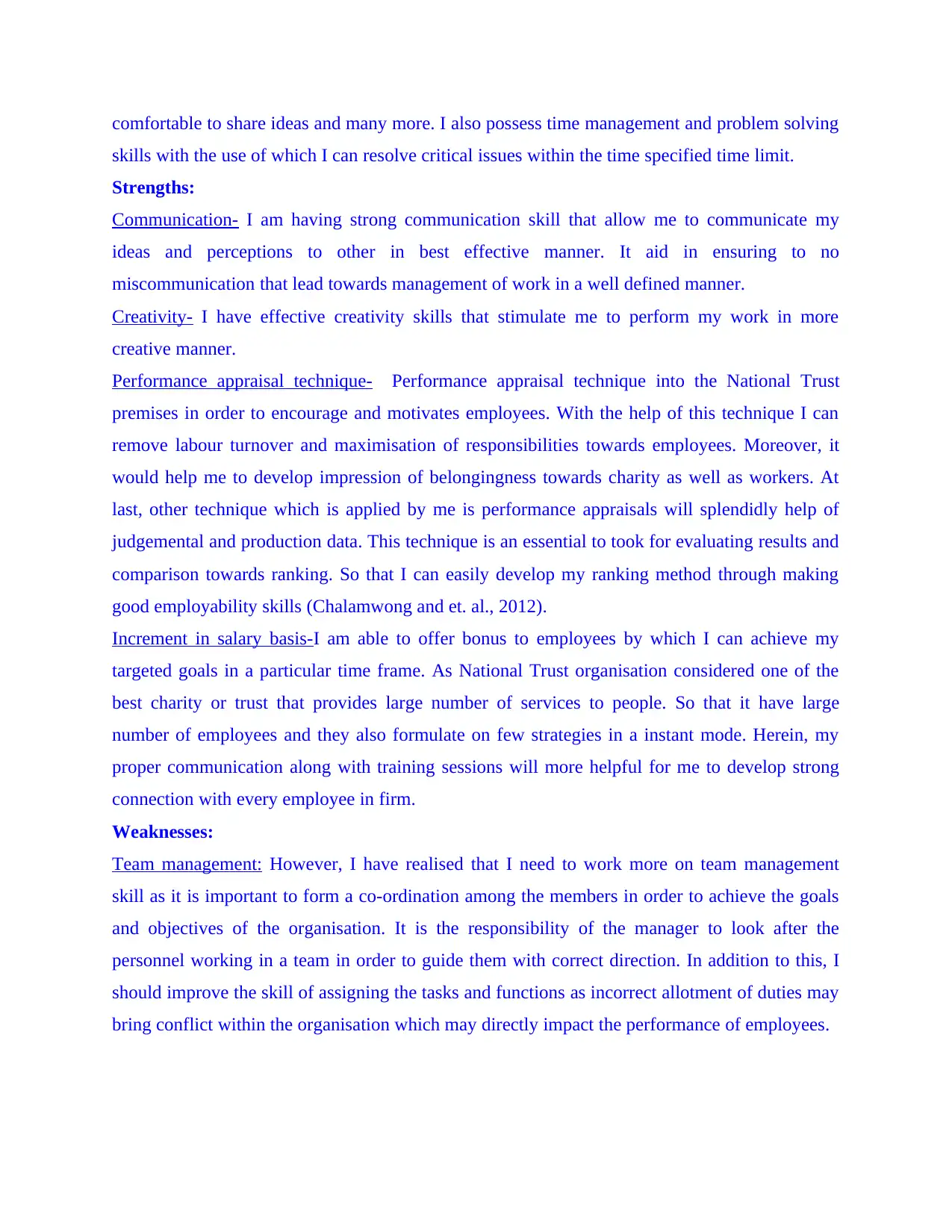
comfortable to share ideas and many more. I also possess time management and problem solving
skills with the use of which I can resolve critical issues within the time specified time limit.
Strengths:
Communication- I am having strong communication skill that allow me to communicate my
ideas and perceptions to other in best effective manner. It aid in ensuring to no
miscommunication that lead towards management of work in a well defined manner.
Creativity- I have effective creativity skills that stimulate me to perform my work in more
creative manner.
Performance appraisal technique- Performance appraisal technique into the National Trust
premises in order to encourage and motivates employees. With the help of this technique I can
remove labour turnover and maximisation of responsibilities towards employees. Moreover, it
would help me to develop impression of belongingness towards charity as well as workers. At
last, other technique which is applied by me is performance appraisals will splendidly help of
judgemental and production data. This technique is an essential to took for evaluating results and
comparison towards ranking. So that I can easily develop my ranking method through making
good employability skills (Chalamwong and et. al., 2012).
Increment in salary basis-I am able to offer bonus to employees by which I can achieve my
targeted goals in a particular time frame. As National Trust organisation considered one of the
best charity or trust that provides large number of services to people. So that it have large
number of employees and they also formulate on few strategies in a instant mode. Herein, my
proper communication along with training sessions will more helpful for me to develop strong
connection with every employee in firm.
Weaknesses:
Team management: However, I have realised that I need to work more on team management
skill as it is important to form a co-ordination among the members in order to achieve the goals
and objectives of the organisation. It is the responsibility of the manager to look after the
personnel working in a team in order to guide them with correct direction. In addition to this, I
should improve the skill of assigning the tasks and functions as incorrect allotment of duties may
bring conflict within the organisation which may directly impact the performance of employees.
skills with the use of which I can resolve critical issues within the time specified time limit.
Strengths:
Communication- I am having strong communication skill that allow me to communicate my
ideas and perceptions to other in best effective manner. It aid in ensuring to no
miscommunication that lead towards management of work in a well defined manner.
Creativity- I have effective creativity skills that stimulate me to perform my work in more
creative manner.
Performance appraisal technique- Performance appraisal technique into the National Trust
premises in order to encourage and motivates employees. With the help of this technique I can
remove labour turnover and maximisation of responsibilities towards employees. Moreover, it
would help me to develop impression of belongingness towards charity as well as workers. At
last, other technique which is applied by me is performance appraisals will splendidly help of
judgemental and production data. This technique is an essential to took for evaluating results and
comparison towards ranking. So that I can easily develop my ranking method through making
good employability skills (Chalamwong and et. al., 2012).
Increment in salary basis-I am able to offer bonus to employees by which I can achieve my
targeted goals in a particular time frame. As National Trust organisation considered one of the
best charity or trust that provides large number of services to people. So that it have large
number of employees and they also formulate on few strategies in a instant mode. Herein, my
proper communication along with training sessions will more helpful for me to develop strong
connection with every employee in firm.
Weaknesses:
Team management: However, I have realised that I need to work more on team management
skill as it is important to form a co-ordination among the members in order to achieve the goals
and objectives of the organisation. It is the responsibility of the manager to look after the
personnel working in a team in order to guide them with correct direction. In addition to this, I
should improve the skill of assigning the tasks and functions as incorrect allotment of duties may
bring conflict within the organisation which may directly impact the performance of employees.
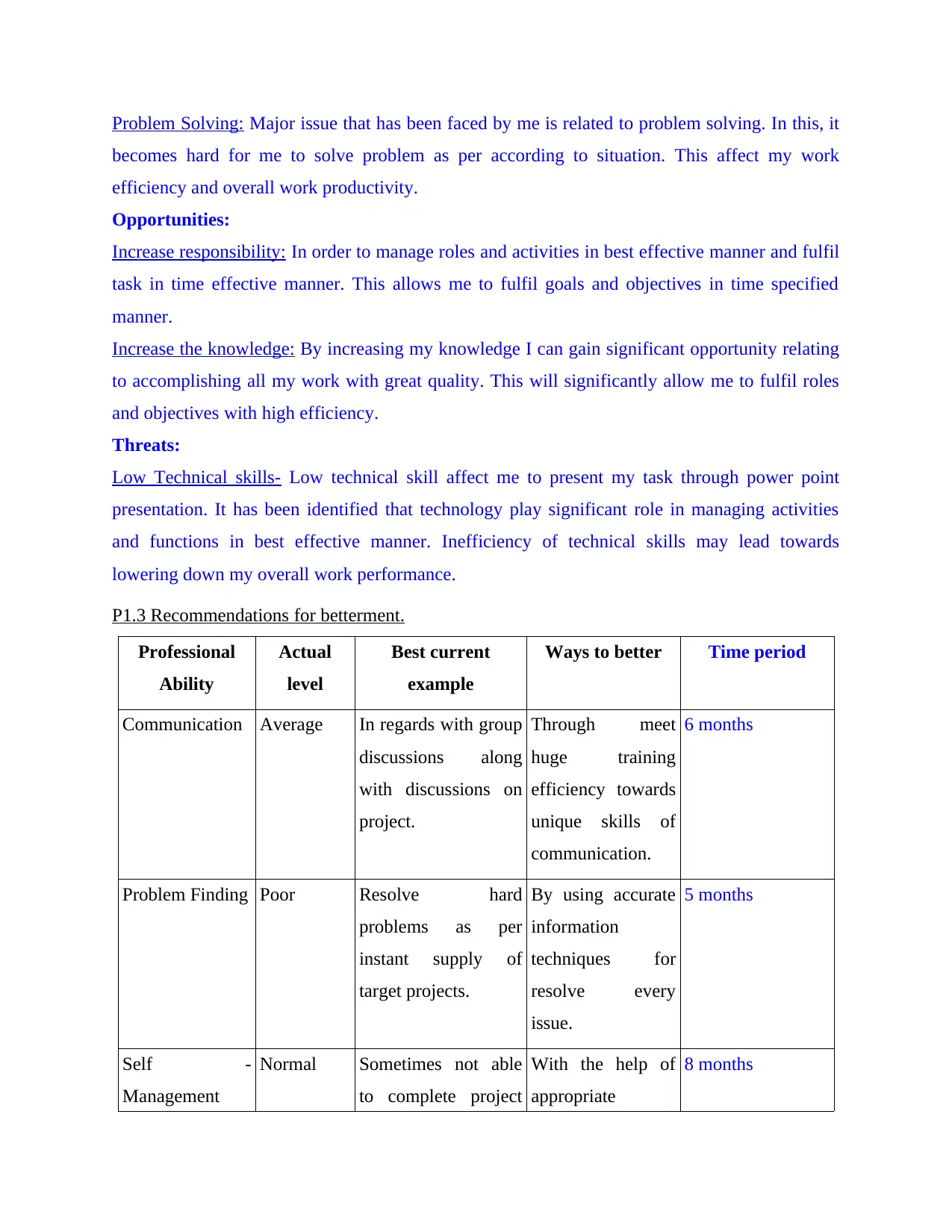
Problem Solving: Major issue that has been faced by me is related to problem solving. In this, it
becomes hard for me to solve problem as per according to situation. This affect my work
efficiency and overall work productivity.
Opportunities:
Increase responsibility: In order to manage roles and activities in best effective manner and fulfil
task in time effective manner. This allows me to fulfil goals and objectives in time specified
manner.
Increase the knowledge: By increasing my knowledge I can gain significant opportunity relating
to accomplishing all my work with great quality. This will significantly allow me to fulfil roles
and objectives with high efficiency.
Threats:
Low Technical skills- Low technical skill affect me to present my task through power point
presentation. It has been identified that technology play significant role in managing activities
and functions in best effective manner. Inefficiency of technical skills may lead towards
lowering down my overall work performance.
P1.3 Recommendations for betterment.
Professional
Ability
Actual
level
Best current
example
Ways to better Time period
Communication Average In regards with group
discussions along
with discussions on
project.
Through meet
huge training
efficiency towards
unique skills of
communication.
6 months
Problem Finding Poor Resolve hard
problems as per
instant supply of
target projects.
By using accurate
information
techniques for
resolve every
issue.
5 months
Self -
Management
Normal Sometimes not able
to complete project
With the help of
appropriate
8 months
becomes hard for me to solve problem as per according to situation. This affect my work
efficiency and overall work productivity.
Opportunities:
Increase responsibility: In order to manage roles and activities in best effective manner and fulfil
task in time effective manner. This allows me to fulfil goals and objectives in time specified
manner.
Increase the knowledge: By increasing my knowledge I can gain significant opportunity relating
to accomplishing all my work with great quality. This will significantly allow me to fulfil roles
and objectives with high efficiency.
Threats:
Low Technical skills- Low technical skill affect me to present my task through power point
presentation. It has been identified that technology play significant role in managing activities
and functions in best effective manner. Inefficiency of technical skills may lead towards
lowering down my overall work performance.
P1.3 Recommendations for betterment.
Professional
Ability
Actual
level
Best current
example
Ways to better Time period
Communication Average In regards with group
discussions along
with discussions on
project.
Through meet
huge training
efficiency towards
unique skills of
communication.
6 months
Problem Finding Poor Resolve hard
problems as per
instant supply of
target projects.
By using accurate
information
techniques for
resolve every
issue.
5 months
Self -
Management
Normal Sometimes not able
to complete project
With the help of
appropriate
8 months
⊘ This is a preview!⊘
Do you want full access?
Subscribe today to unlock all pages.

Trusted by 1+ million students worldwide
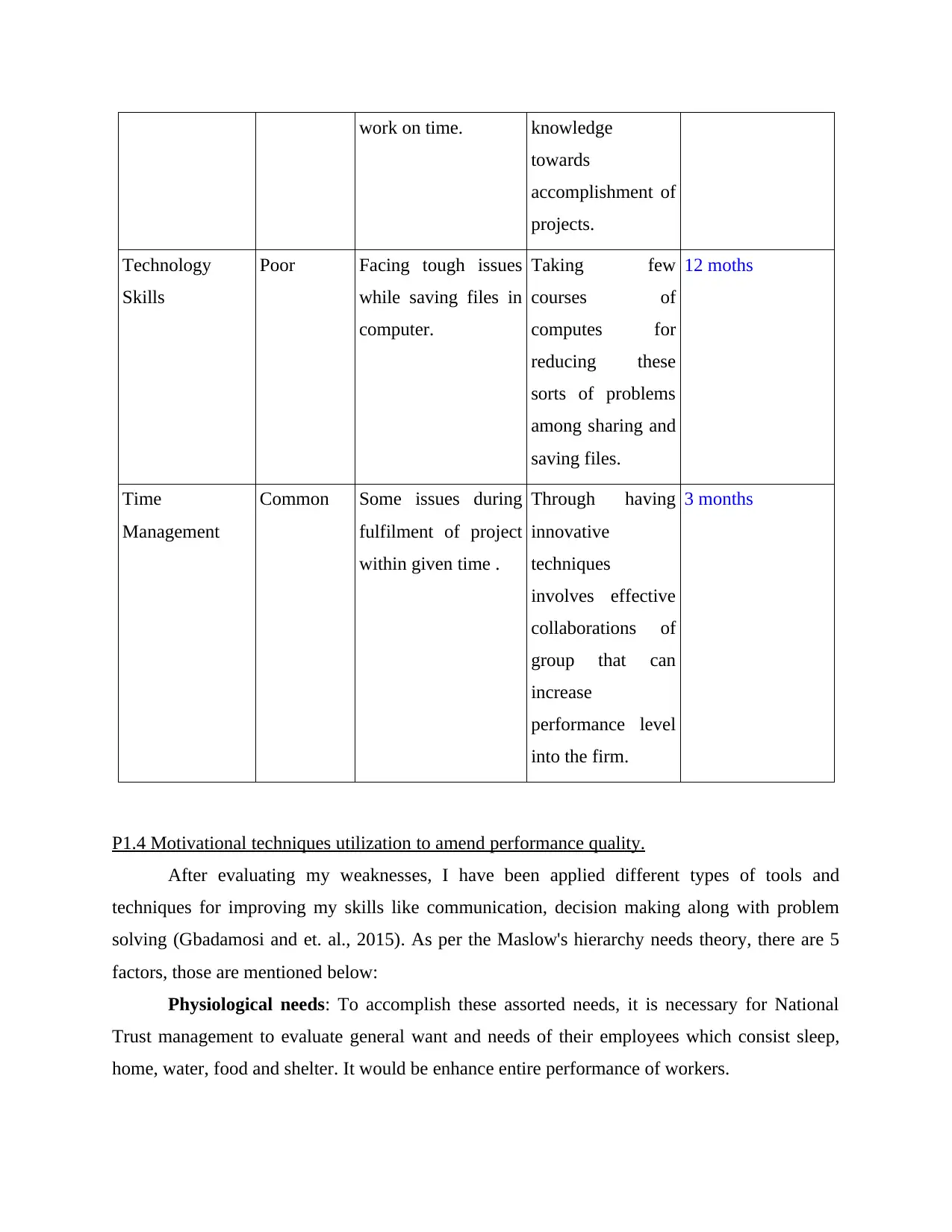
work on time. knowledge
towards
accomplishment of
projects.
Technology
Skills
Poor Facing tough issues
while saving files in
computer.
Taking few
courses of
computes for
reducing these
sorts of problems
among sharing and
saving files.
12 moths
Time
Management
Common Some issues during
fulfilment of project
within given time .
Through having
innovative
techniques
involves effective
collaborations of
group that can
increase
performance level
into the firm.
3 months
P1.4 Motivational techniques utilization to amend performance quality.
After evaluating my weaknesses, I have been applied different types of tools and
techniques for improving my skills like communication, decision making along with problem
solving (Gbadamosi and et. al., 2015). As per the Maslow's hierarchy needs theory, there are 5
factors, those are mentioned below:
Physiological needs: To accomplish these assorted needs, it is necessary for National
Trust management to evaluate general want and needs of their employees which consist sleep,
home, water, food and shelter. It would be enhance entire performance of workers.
towards
accomplishment of
projects.
Technology
Skills
Poor Facing tough issues
while saving files in
computer.
Taking few
courses of
computes for
reducing these
sorts of problems
among sharing and
saving files.
12 moths
Time
Management
Common Some issues during
fulfilment of project
within given time .
Through having
innovative
techniques
involves effective
collaborations of
group that can
increase
performance level
into the firm.
3 months
P1.4 Motivational techniques utilization to amend performance quality.
After evaluating my weaknesses, I have been applied different types of tools and
techniques for improving my skills like communication, decision making along with problem
solving (Gbadamosi and et. al., 2015). As per the Maslow's hierarchy needs theory, there are 5
factors, those are mentioned below:
Physiological needs: To accomplish these assorted needs, it is necessary for National
Trust management to evaluate general want and needs of their employees which consist sleep,
home, water, food and shelter. It would be enhance entire performance of workers.
Paraphrase This Document
Need a fresh take? Get an instant paraphrase of this document with our AI Paraphraser
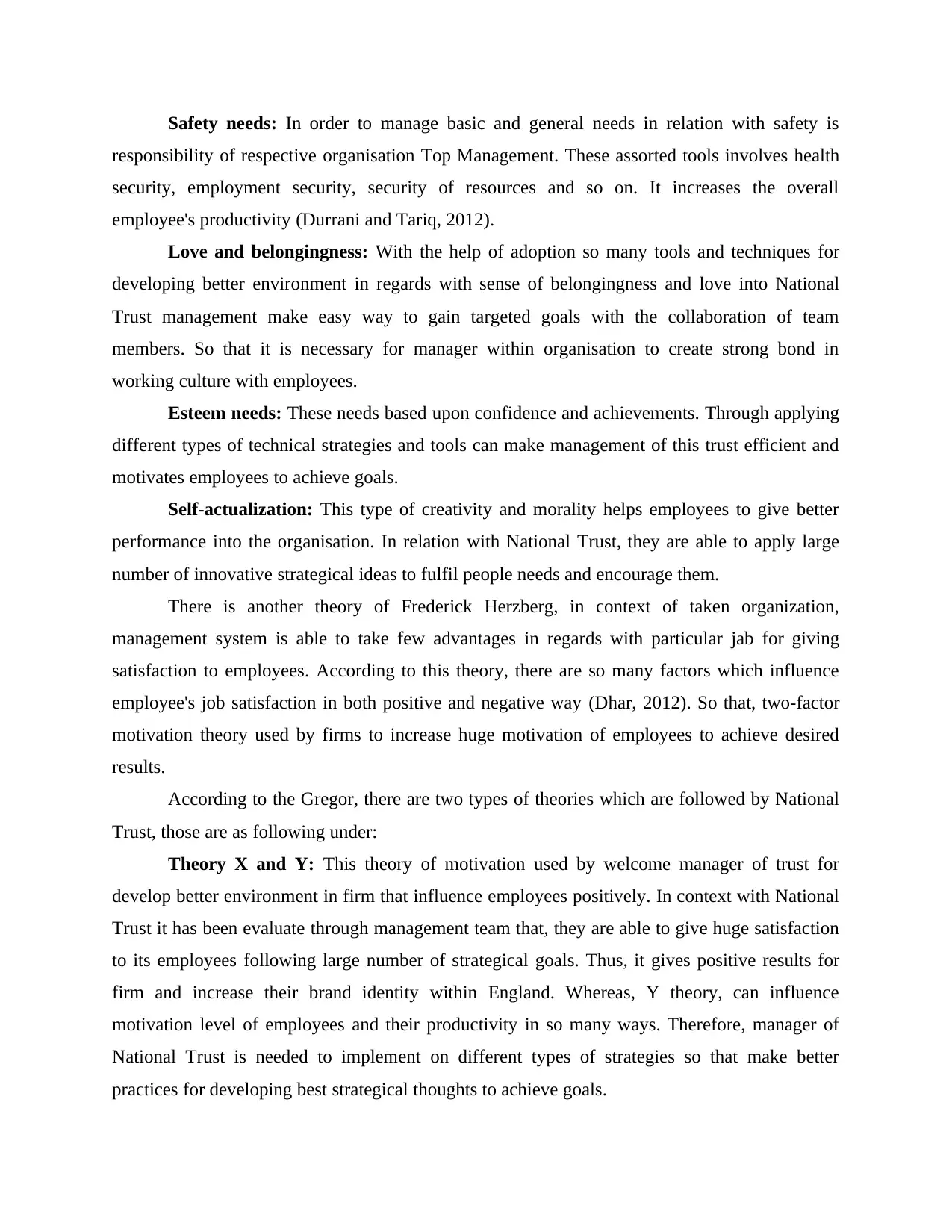
Safety needs: In order to manage basic and general needs in relation with safety is
responsibility of respective organisation Top Management. These assorted tools involves health
security, employment security, security of resources and so on. It increases the overall
employee's productivity (Durrani and Tariq, 2012).
Love and belongingness: With the help of adoption so many tools and techniques for
developing better environment in regards with sense of belongingness and love into National
Trust management make easy way to gain targeted goals with the collaboration of team
members. So that it is necessary for manager within organisation to create strong bond in
working culture with employees.
Esteem needs: These needs based upon confidence and achievements. Through applying
different types of technical strategies and tools can make management of this trust efficient and
motivates employees to achieve goals.
Self-actualization: This type of creativity and morality helps employees to give better
performance into the organisation. In relation with National Trust, they are able to apply large
number of innovative strategical ideas to fulfil people needs and encourage them.
There is another theory of Frederick Herzberg, in context of taken organization,
management system is able to take few advantages in regards with particular jab for giving
satisfaction to employees. According to this theory, there are so many factors which influence
employee's job satisfaction in both positive and negative way (Dhar, 2012). So that, two-factor
motivation theory used by firms to increase huge motivation of employees to achieve desired
results.
According to the Gregor, there are two types of theories which are followed by National
Trust, those are as following under:
Theory X and Y: This theory of motivation used by welcome manager of trust for
develop better environment in firm that influence employees positively. In context with National
Trust it has been evaluate through management team that, they are able to give huge satisfaction
to its employees following large number of strategical goals. Thus, it gives positive results for
firm and increase their brand identity within England. Whereas, Y theory, can influence
motivation level of employees and their productivity in so many ways. Therefore, manager of
National Trust is needed to implement on different types of strategies so that make better
practices for developing best strategical thoughts to achieve goals.
responsibility of respective organisation Top Management. These assorted tools involves health
security, employment security, security of resources and so on. It increases the overall
employee's productivity (Durrani and Tariq, 2012).
Love and belongingness: With the help of adoption so many tools and techniques for
developing better environment in regards with sense of belongingness and love into National
Trust management make easy way to gain targeted goals with the collaboration of team
members. So that it is necessary for manager within organisation to create strong bond in
working culture with employees.
Esteem needs: These needs based upon confidence and achievements. Through applying
different types of technical strategies and tools can make management of this trust efficient and
motivates employees to achieve goals.
Self-actualization: This type of creativity and morality helps employees to give better
performance into the organisation. In relation with National Trust, they are able to apply large
number of innovative strategical ideas to fulfil people needs and encourage them.
There is another theory of Frederick Herzberg, in context of taken organization,
management system is able to take few advantages in regards with particular jab for giving
satisfaction to employees. According to this theory, there are so many factors which influence
employee's job satisfaction in both positive and negative way (Dhar, 2012). So that, two-factor
motivation theory used by firms to increase huge motivation of employees to achieve desired
results.
According to the Gregor, there are two types of theories which are followed by National
Trust, those are as following under:
Theory X and Y: This theory of motivation used by welcome manager of trust for
develop better environment in firm that influence employees positively. In context with National
Trust it has been evaluate through management team that, they are able to give huge satisfaction
to its employees following large number of strategical goals. Thus, it gives positive results for
firm and increase their brand identity within England. Whereas, Y theory, can influence
motivation level of employees and their productivity in so many ways. Therefore, manager of
National Trust is needed to implement on different types of strategies so that make better
practices for developing best strategical thoughts to achieve goals.
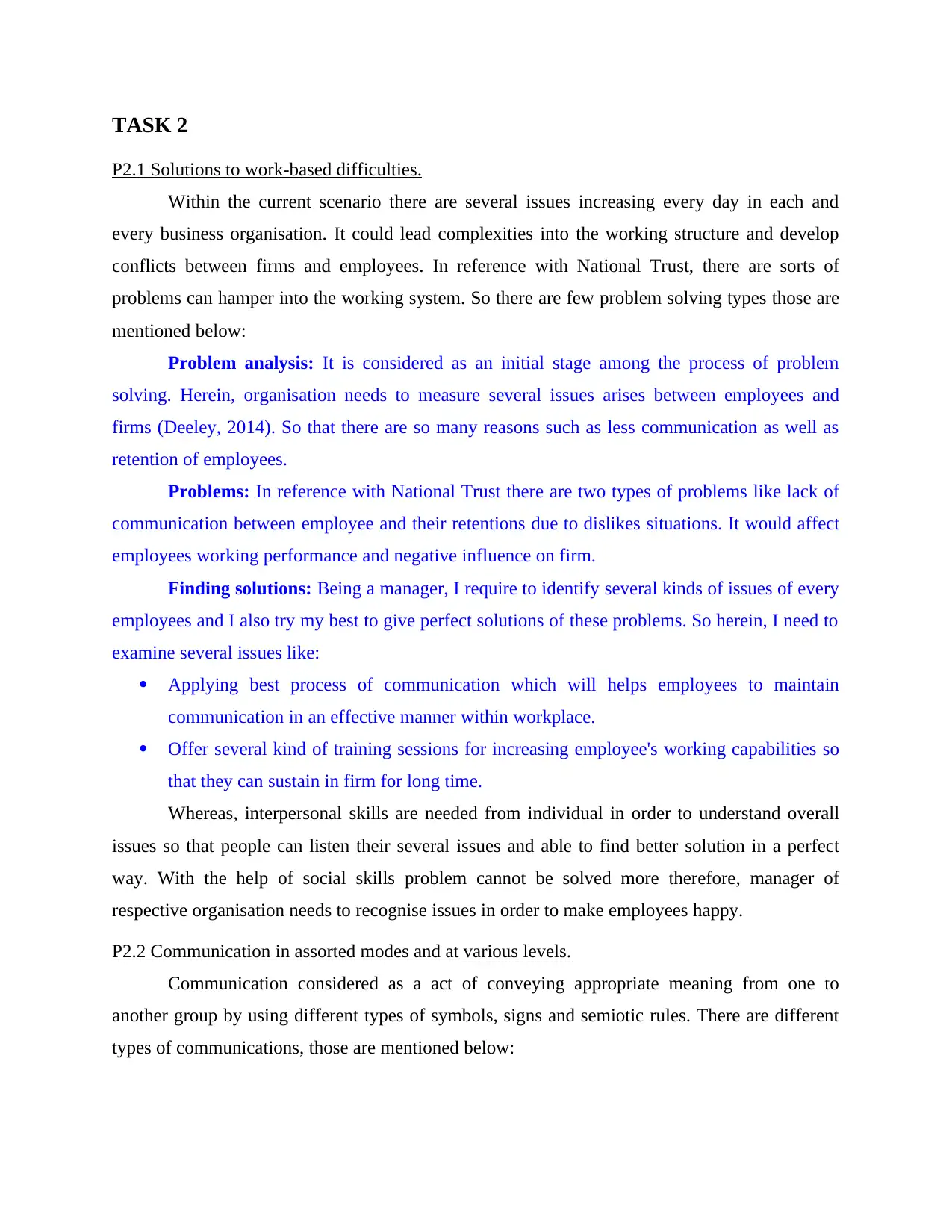
TASK 2
P2.1 Solutions to work-based difficulties.
Within the current scenario there are several issues increasing every day in each and
every business organisation. It could lead complexities into the working structure and develop
conflicts between firms and employees. In reference with National Trust, there are sorts of
problems can hamper into the working system. So there are few problem solving types those are
mentioned below:
Problem analysis: It is considered as an initial stage among the process of problem
solving. Herein, organisation needs to measure several issues arises between employees and
firms (Deeley, 2014). So that there are so many reasons such as less communication as well as
retention of employees.
Problems: In reference with National Trust there are two types of problems like lack of
communication between employee and their retentions due to dislikes situations. It would affect
employees working performance and negative influence on firm.
Finding solutions: Being a manager, I require to identify several kinds of issues of every
employees and I also try my best to give perfect solutions of these problems. So herein, I need to
examine several issues like:
Applying best process of communication which will helps employees to maintain
communication in an effective manner within workplace.
Offer several kind of training sessions for increasing employee's working capabilities so
that they can sustain in firm for long time.
Whereas, interpersonal skills are needed from individual in order to understand overall
issues so that people can listen their several issues and able to find better solution in a perfect
way. With the help of social skills problem cannot be solved more therefore, manager of
respective organisation needs to recognise issues in order to make employees happy.
P2.2 Communication in assorted modes and at various levels.
Communication considered as a act of conveying appropriate meaning from one to
another group by using different types of symbols, signs and semiotic rules. There are different
types of communications, those are mentioned below:
P2.1 Solutions to work-based difficulties.
Within the current scenario there are several issues increasing every day in each and
every business organisation. It could lead complexities into the working structure and develop
conflicts between firms and employees. In reference with National Trust, there are sorts of
problems can hamper into the working system. So there are few problem solving types those are
mentioned below:
Problem analysis: It is considered as an initial stage among the process of problem
solving. Herein, organisation needs to measure several issues arises between employees and
firms (Deeley, 2014). So that there are so many reasons such as less communication as well as
retention of employees.
Problems: In reference with National Trust there are two types of problems like lack of
communication between employee and their retentions due to dislikes situations. It would affect
employees working performance and negative influence on firm.
Finding solutions: Being a manager, I require to identify several kinds of issues of every
employees and I also try my best to give perfect solutions of these problems. So herein, I need to
examine several issues like:
Applying best process of communication which will helps employees to maintain
communication in an effective manner within workplace.
Offer several kind of training sessions for increasing employee's working capabilities so
that they can sustain in firm for long time.
Whereas, interpersonal skills are needed from individual in order to understand overall
issues so that people can listen their several issues and able to find better solution in a perfect
way. With the help of social skills problem cannot be solved more therefore, manager of
respective organisation needs to recognise issues in order to make employees happy.
P2.2 Communication in assorted modes and at various levels.
Communication considered as a act of conveying appropriate meaning from one to
another group by using different types of symbols, signs and semiotic rules. There are different
types of communications, those are mentioned below:
⊘ This is a preview!⊘
Do you want full access?
Subscribe today to unlock all pages.

Trusted by 1+ million students worldwide
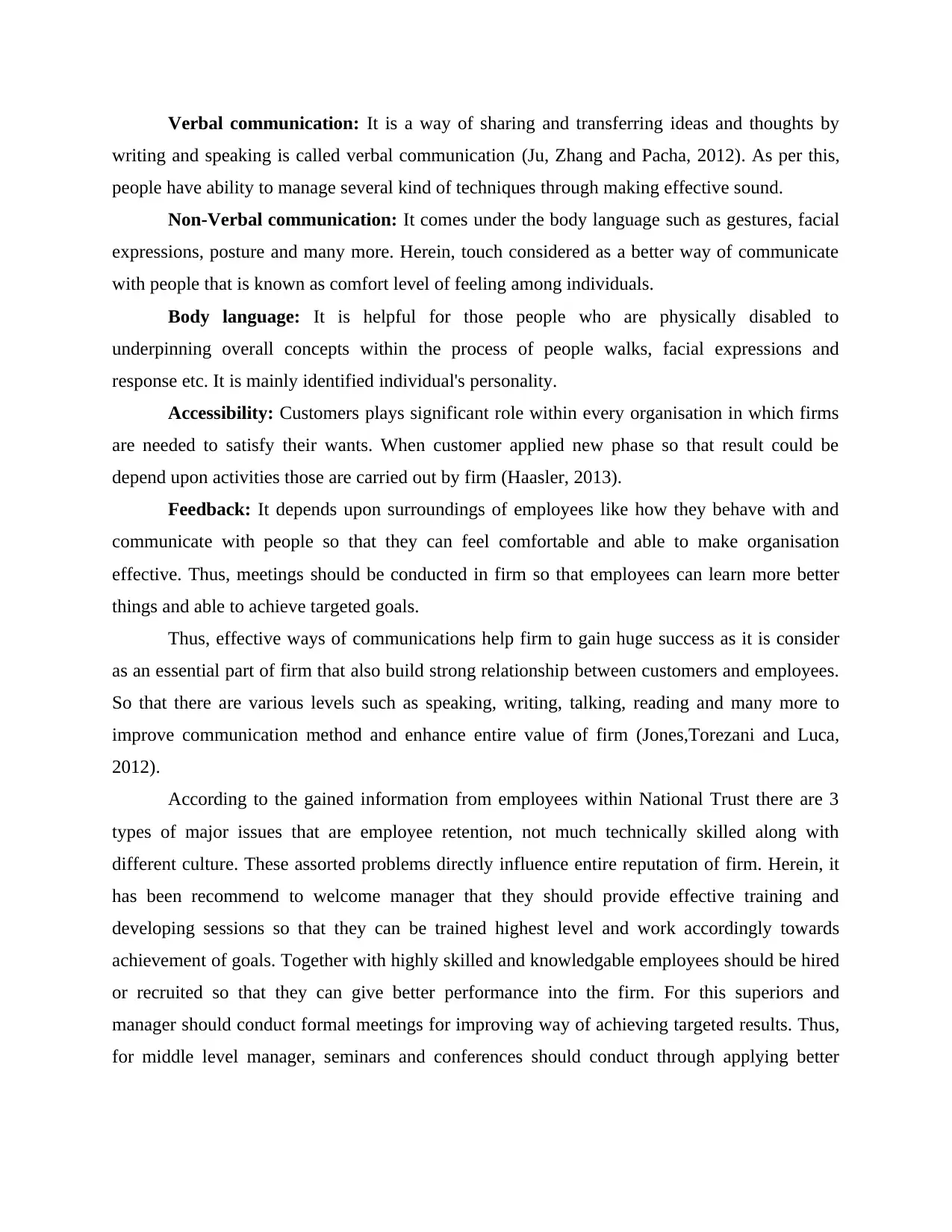
Verbal communication: It is a way of sharing and transferring ideas and thoughts by
writing and speaking is called verbal communication (Ju, Zhang and Pacha, 2012). As per this,
people have ability to manage several kind of techniques through making effective sound.
Non-Verbal communication: It comes under the body language such as gestures, facial
expressions, posture and many more. Herein, touch considered as a better way of communicate
with people that is known as comfort level of feeling among individuals.
Body language: It is helpful for those people who are physically disabled to
underpinning overall concepts within the process of people walks, facial expressions and
response etc. It is mainly identified individual's personality.
Accessibility: Customers plays significant role within every organisation in which firms
are needed to satisfy their wants. When customer applied new phase so that result could be
depend upon activities those are carried out by firm (Haasler, 2013).
Feedback: It depends upon surroundings of employees like how they behave with and
communicate with people so that they can feel comfortable and able to make organisation
effective. Thus, meetings should be conducted in firm so that employees can learn more better
things and able to achieve targeted goals.
Thus, effective ways of communications help firm to gain huge success as it is consider
as an essential part of firm that also build strong relationship between customers and employees.
So that there are various levels such as speaking, writing, talking, reading and many more to
improve communication method and enhance entire value of firm (Jones,Torezani and Luca,
2012).
According to the gained information from employees within National Trust there are 3
types of major issues that are employee retention, not much technically skilled along with
different culture. These assorted problems directly influence entire reputation of firm. Herein, it
has been recommend to welcome manager that they should provide effective training and
developing sessions so that they can be trained highest level and work accordingly towards
achievement of goals. Together with highly skilled and knowledgable employees should be hired
or recruited so that they can give better performance into the firm. For this superiors and
manager should conduct formal meetings for improving way of achieving targeted results. Thus,
for middle level manager, seminars and conferences should conduct through applying better
writing and speaking is called verbal communication (Ju, Zhang and Pacha, 2012). As per this,
people have ability to manage several kind of techniques through making effective sound.
Non-Verbal communication: It comes under the body language such as gestures, facial
expressions, posture and many more. Herein, touch considered as a better way of communicate
with people that is known as comfort level of feeling among individuals.
Body language: It is helpful for those people who are physically disabled to
underpinning overall concepts within the process of people walks, facial expressions and
response etc. It is mainly identified individual's personality.
Accessibility: Customers plays significant role within every organisation in which firms
are needed to satisfy their wants. When customer applied new phase so that result could be
depend upon activities those are carried out by firm (Haasler, 2013).
Feedback: It depends upon surroundings of employees like how they behave with and
communicate with people so that they can feel comfortable and able to make organisation
effective. Thus, meetings should be conducted in firm so that employees can learn more better
things and able to achieve targeted goals.
Thus, effective ways of communications help firm to gain huge success as it is consider
as an essential part of firm that also build strong relationship between customers and employees.
So that there are various levels such as speaking, writing, talking, reading and many more to
improve communication method and enhance entire value of firm (Jones,Torezani and Luca,
2012).
According to the gained information from employees within National Trust there are 3
types of major issues that are employee retention, not much technically skilled along with
different culture. These assorted problems directly influence entire reputation of firm. Herein, it
has been recommend to welcome manager that they should provide effective training and
developing sessions so that they can be trained highest level and work accordingly towards
achievement of goals. Together with highly skilled and knowledgable employees should be hired
or recruited so that they can give better performance into the firm. For this superiors and
manager should conduct formal meetings for improving way of achieving targeted results. Thus,
for middle level manager, seminars and conferences should conduct through applying better
Paraphrase This Document
Need a fresh take? Get an instant paraphrase of this document with our AI Paraphraser
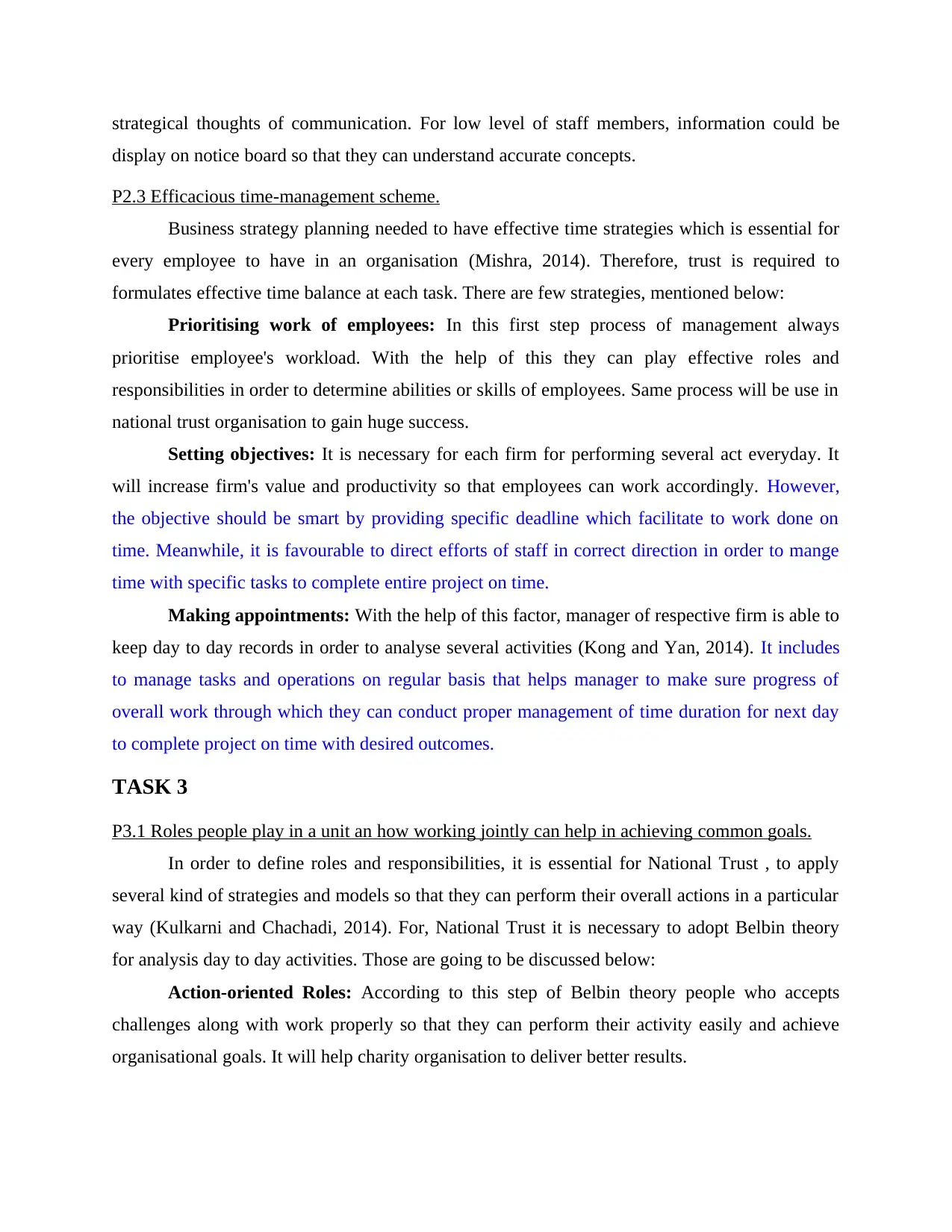
strategical thoughts of communication. For low level of staff members, information could be
display on notice board so that they can understand accurate concepts.
P2.3 Efficacious time-management scheme.
Business strategy planning needed to have effective time strategies which is essential for
every employee to have in an organisation (Mishra, 2014). Therefore, trust is required to
formulates effective time balance at each task. There are few strategies, mentioned below:
Prioritising work of employees: In this first step process of management always
prioritise employee's workload. With the help of this they can play effective roles and
responsibilities in order to determine abilities or skills of employees. Same process will be use in
national trust organisation to gain huge success.
Setting objectives: It is necessary for each firm for performing several act everyday. It
will increase firm's value and productivity so that employees can work accordingly. However,
the objective should be smart by providing specific deadline which facilitate to work done on
time. Meanwhile, it is favourable to direct efforts of staff in correct direction in order to mange
time with specific tasks to complete entire project on time.
Making appointments: With the help of this factor, manager of respective firm is able to
keep day to day records in order to analyse several activities (Kong and Yan, 2014). It includes
to manage tasks and operations on regular basis that helps manager to make sure progress of
overall work through which they can conduct proper management of time duration for next day
to complete project on time with desired outcomes.
TASK 3
P3.1 Roles people play in a unit an how working jointly can help in achieving common goals.
In order to define roles and responsibilities, it is essential for National Trust , to apply
several kind of strategies and models so that they can perform their overall actions in a particular
way (Kulkarni and Chachadi, 2014). For, National Trust it is necessary to adopt Belbin theory
for analysis day to day activities. Those are going to be discussed below:
Action-oriented Roles: According to this step of Belbin theory people who accepts
challenges along with work properly so that they can perform their activity easily and achieve
organisational goals. It will help charity organisation to deliver better results.
display on notice board so that they can understand accurate concepts.
P2.3 Efficacious time-management scheme.
Business strategy planning needed to have effective time strategies which is essential for
every employee to have in an organisation (Mishra, 2014). Therefore, trust is required to
formulates effective time balance at each task. There are few strategies, mentioned below:
Prioritising work of employees: In this first step process of management always
prioritise employee's workload. With the help of this they can play effective roles and
responsibilities in order to determine abilities or skills of employees. Same process will be use in
national trust organisation to gain huge success.
Setting objectives: It is necessary for each firm for performing several act everyday. It
will increase firm's value and productivity so that employees can work accordingly. However,
the objective should be smart by providing specific deadline which facilitate to work done on
time. Meanwhile, it is favourable to direct efforts of staff in correct direction in order to mange
time with specific tasks to complete entire project on time.
Making appointments: With the help of this factor, manager of respective firm is able to
keep day to day records in order to analyse several activities (Kong and Yan, 2014). It includes
to manage tasks and operations on regular basis that helps manager to make sure progress of
overall work through which they can conduct proper management of time duration for next day
to complete project on time with desired outcomes.
TASK 3
P3.1 Roles people play in a unit an how working jointly can help in achieving common goals.
In order to define roles and responsibilities, it is essential for National Trust , to apply
several kind of strategies and models so that they can perform their overall actions in a particular
way (Kulkarni and Chachadi, 2014). For, National Trust it is necessary to adopt Belbin theory
for analysis day to day activities. Those are going to be discussed below:
Action-oriented Roles: According to this step of Belbin theory people who accepts
challenges along with work properly so that they can perform their activity easily and achieve
organisational goals. It will help charity organisation to deliver better results.
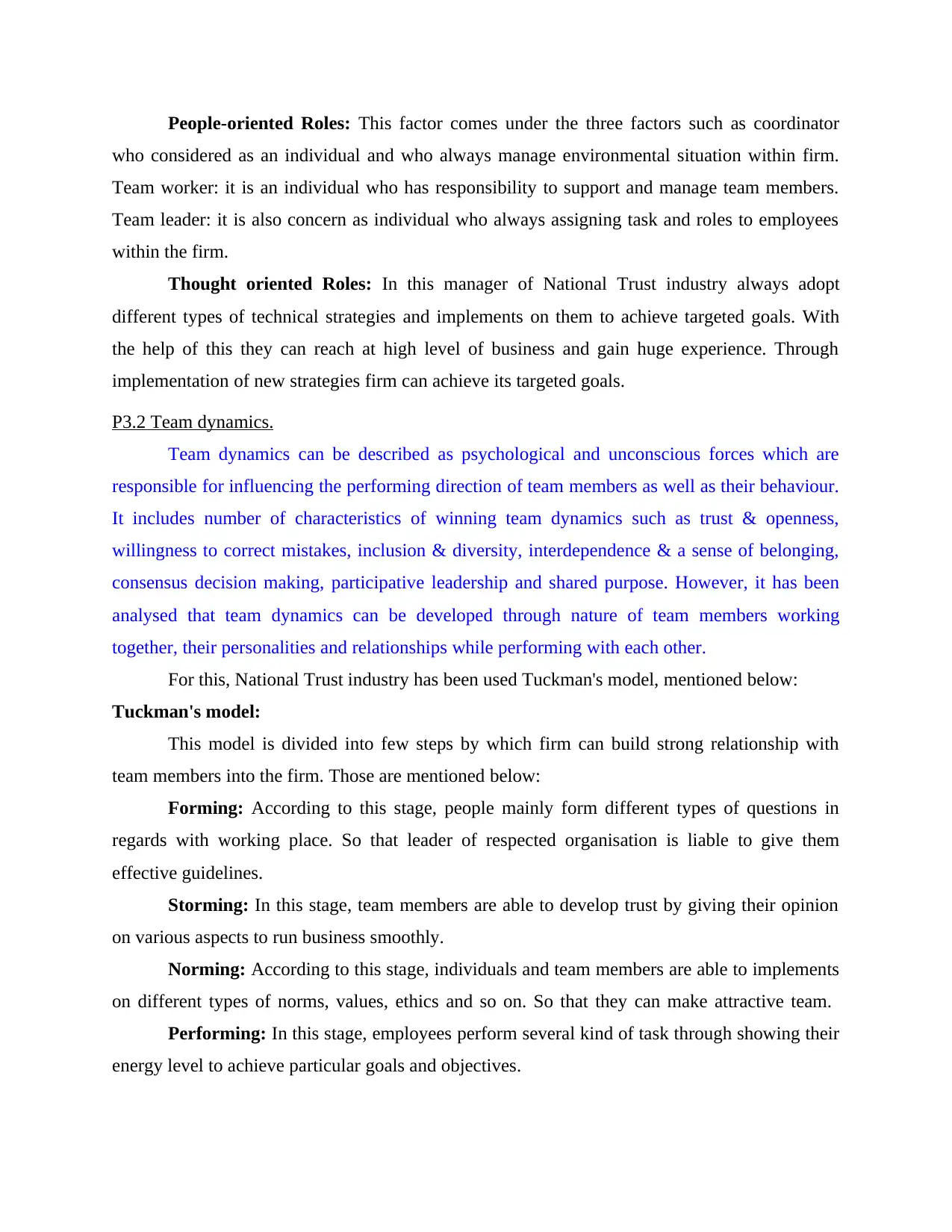
People-oriented Roles: This factor comes under the three factors such as coordinator
who considered as an individual and who always manage environmental situation within firm.
Team worker: it is an individual who has responsibility to support and manage team members.
Team leader: it is also concern as individual who always assigning task and roles to employees
within the firm.
Thought oriented Roles: In this manager of National Trust industry always adopt
different types of technical strategies and implements on them to achieve targeted goals. With
the help of this they can reach at high level of business and gain huge experience. Through
implementation of new strategies firm can achieve its targeted goals.
P3.2 Team dynamics.
Team dynamics can be described as psychological and unconscious forces which are
responsible for influencing the performing direction of team members as well as their behaviour.
It includes number of characteristics of winning team dynamics such as trust & openness,
willingness to correct mistakes, inclusion & diversity, interdependence & a sense of belonging,
consensus decision making, participative leadership and shared purpose. However, it has been
analysed that team dynamics can be developed through nature of team members working
together, their personalities and relationships while performing with each other.
For this, National Trust industry has been used Tuckman's model, mentioned below:
Tuckman's model:
This model is divided into few steps by which firm can build strong relationship with
team members into the firm. Those are mentioned below:
Forming: According to this stage, people mainly form different types of questions in
regards with working place. So that leader of respected organisation is liable to give them
effective guidelines.
Storming: In this stage, team members are able to develop trust by giving their opinion
on various aspects to run business smoothly.
Norming: According to this stage, individuals and team members are able to implements
on different types of norms, values, ethics and so on. So that they can make attractive team.
Performing: In this stage, employees perform several kind of task through showing their
energy level to achieve particular goals and objectives.
who considered as an individual and who always manage environmental situation within firm.
Team worker: it is an individual who has responsibility to support and manage team members.
Team leader: it is also concern as individual who always assigning task and roles to employees
within the firm.
Thought oriented Roles: In this manager of National Trust industry always adopt
different types of technical strategies and implements on them to achieve targeted goals. With
the help of this they can reach at high level of business and gain huge experience. Through
implementation of new strategies firm can achieve its targeted goals.
P3.2 Team dynamics.
Team dynamics can be described as psychological and unconscious forces which are
responsible for influencing the performing direction of team members as well as their behaviour.
It includes number of characteristics of winning team dynamics such as trust & openness,
willingness to correct mistakes, inclusion & diversity, interdependence & a sense of belonging,
consensus decision making, participative leadership and shared purpose. However, it has been
analysed that team dynamics can be developed through nature of team members working
together, their personalities and relationships while performing with each other.
For this, National Trust industry has been used Tuckman's model, mentioned below:
Tuckman's model:
This model is divided into few steps by which firm can build strong relationship with
team members into the firm. Those are mentioned below:
Forming: According to this stage, people mainly form different types of questions in
regards with working place. So that leader of respected organisation is liable to give them
effective guidelines.
Storming: In this stage, team members are able to develop trust by giving their opinion
on various aspects to run business smoothly.
Norming: According to this stage, individuals and team members are able to implements
on different types of norms, values, ethics and so on. So that they can make attractive team.
Performing: In this stage, employees perform several kind of task through showing their
energy level to achieve particular goals and objectives.
⊘ This is a preview!⊘
Do you want full access?
Subscribe today to unlock all pages.

Trusted by 1+ million students worldwide
1 out of 18
Related Documents
Your All-in-One AI-Powered Toolkit for Academic Success.
+13062052269
info@desklib.com
Available 24*7 on WhatsApp / Email
![[object Object]](/_next/static/media/star-bottom.7253800d.svg)
Unlock your academic potential
Copyright © 2020–2025 A2Z Services. All Rights Reserved. Developed and managed by ZUCOL.





